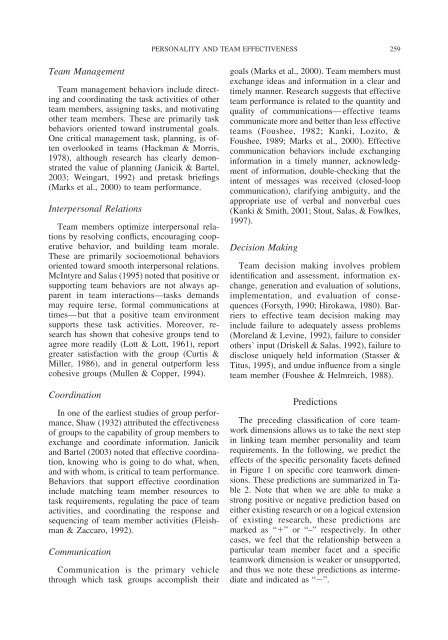What makes a good team player? Personality and team effectiveness
What makes a good team player? Personality and team effectiveness
What makes a good team player? Personality and team effectiveness
- No tags were found...
Create successful ePaper yourself
Turn your PDF publications into a flip-book with our unique Google optimized e-Paper software.
PERSONALITY AND TEAM EFFECTIVENESS259Team ManagementTeam management behaviors include directing<strong>and</strong> coordinating the task activities of other<strong>team</strong> members, assigning tasks, <strong>and</strong> motivatingother <strong>team</strong> members. These are primarily taskbehaviors oriented toward instrumental goals.One critical management task, planning, is oftenoverlooked in <strong>team</strong>s (Hackman & Morris,1978), although research has clearly demonstratedthe value of planning (Janicik & Bartel,2003; Weingart, 1992) <strong>and</strong> pretask briefings(Marks et al., 2000) to <strong>team</strong> performance.Interpersonal RelationsTeam members optimize interpersonal relationsby resolving conflicts, encouraging cooperativebehavior, <strong>and</strong> building <strong>team</strong> morale.These are primarily socioemotional behaviorsoriented toward smooth interpersonal relations.McIntyre <strong>and</strong> Salas (1995) noted that positive orsupporting <strong>team</strong> behaviors are not always apparentin <strong>team</strong> interactions—tasks dem<strong>and</strong>smay require terse, formal communications attimes—but that a positive <strong>team</strong> environmentsupports these task activities. Moreover, researchhas shown that cohesive groups tend toagree more readily (Lott & Lott, 1961), reportgreater satisfaction with the group (Curtis &Miller, 1986), <strong>and</strong> in general outperform lesscohesive groups (Mullen & Copper, 1994).CoordinationIn one of the earliest studies of group performance,Shaw (1932) attributed the <strong>effectiveness</strong>of groups to the capability of group members toexchange <strong>and</strong> coordinate information. Janicik<strong>and</strong> Bartel (2003) noted that effective coordination,knowing who is going to do what, when,<strong>and</strong> with whom, is critical to <strong>team</strong> performance.Behaviors that support effective coordinationinclude matching <strong>team</strong> member resources totask requirements, regulating the pace of <strong>team</strong>activities, <strong>and</strong> coordinating the response <strong>and</strong>sequencing of <strong>team</strong> member activities (Fleishman& Zaccaro, 1992).CommunicationCommunication is the primary vehiclethrough which task groups accomplish theirgoals (Marks et al., 2000). Team members mustexchange ideas <strong>and</strong> information in a clear <strong>and</strong>timely manner. Research suggests that effective<strong>team</strong> performance is related to the quantity <strong>and</strong>quality of communications—effective <strong>team</strong>scommunicate more <strong>and</strong> better than less effective<strong>team</strong>s (Foushee, 1982; Kanki, Lozito, &Foushee, 1989; Marks et al., 2000). Effectivecommunication behaviors include exchanginginformation in a timely manner, acknowledgmentof information, double-checking that theintent of messages was received (closed-loopcommunication), clarifying ambiguity, <strong>and</strong> theappropriate use of verbal <strong>and</strong> nonverbal cues(Kanki & Smith, 2001; Stout, Salas, & Fowlkes,1997).Decision MakingTeam decision making involves problemidentification <strong>and</strong> assessment, information exchange,generation <strong>and</strong> evaluation of solutions,implementation, <strong>and</strong> evaluation of consequences(Forsyth, 1990; Hirokawa, 1980). Barriersto effective <strong>team</strong> decision making mayinclude failure to adequately assess problems(Morel<strong>and</strong> & Levine, 1992), failure to considerothers’ input (Driskell & Salas, 1992), failure todisclose uniquely held information (Stasser &Titus, 1995), <strong>and</strong> undue influence from a single<strong>team</strong> member (Foushee & Helmreich, 1988).PredictionsThe preceding classification of core <strong>team</strong>workdimensions allows us to take the next stepin linking <strong>team</strong> member personality <strong>and</strong> <strong>team</strong>requirements. In the following, we predict theeffects of the specific personality facets definedin Figure 1 on specific core <strong>team</strong>work dimensions.These predictions are summarized in Table2. Note that when we are able to make astrong positive or negative prediction based oneither existing research or on a logical extensionof existing research, these predictions aremarked as “” or “–” respectively. In othercases, we feel that the relationship between aparticular <strong>team</strong> member facet <strong>and</strong> a specific<strong>team</strong>work dimension is weaker or unsupported,<strong>and</strong> thus we note these predictions as intermediate<strong>and</strong> indicated as “”.










